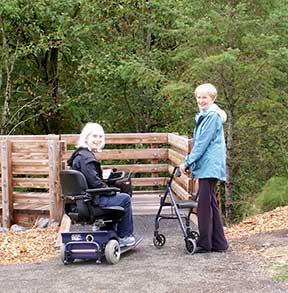 |
Previous Issues |
| Cedar Mill Community Website |
|
Search the Cedar Mill News: |
About The Cedar Mill News |
|
|||||||
| Volume 13, Issue 9 | September 2015 |
||||||
Trails to Transformation
|
|||||
 |
Bonnie Barksdale and Kathy Brown prepare to enjoy a walk on the Sue Conger Memorial Boardwalk, to view Cedar Mill Falls. |
Tualatin Hills Park and Recreation District manages more than 60 miles of urban trails. According to the district’s 2013 comprehensive plan, THPRD’s vision is to “enhance healthy and active lifestyles while connecting more people to nature, parks and programs.” This will be accomplished through “stewardship of public resources and by providing programs/spaces to fulfill unmet needs.”
“We always try to make the trail less than 5%-grade slope when possible,” explains Steve Gulgren, the Superintendant of Design and Development for THPRD.
“We have to weigh out accessibility, environmental sustainability, and cost.”
THPRD doesn’t currently have a list of slope gradations for its trails, or ratings on different aspects of accessibility for trails, although this has been discussed.
The desire for useful trail accessibility information compelled Georgena Moran to establish Access Recreation (accessrecreation.org). AR is a Portland ad hoc committee that develops uniform guidelines for information about trails and recreational facilities that would benefit hikers with disabilities. The goal of AR is not to determine if a trail meets Americans with Disabilities Act (ADA) standards, but to present useful trail information so a person with a disability can make an informed decision.
AR is partnering with THPRD to generate this information. They have already produced a video of the Tualatin Hills Nature Park, and plan to assess Fanno Creek Trail, Lowami Hart Woods, and Cooper Mountain Nature Park over the next year.
People of all abilities gain a wide array of benefits, both physical and psychological, from experiencing the outdoors. Physical activity positively affects concentration, enhances creativity, helps memory and increases one’s sense of accomplishment and confidence.
According to the National Consortium for Physical Education and Recreation for Individuals with Disabilities, recreational activities help develop a healthy lifestyle, enhance self-esteem and self-image, and encourages friendships with peers by increasing socialization opportunities.
Furthermore, these activities foster independence, and reduce anxiety and depression. Lastly, recreation increases tolerance and understanding between those with and without disabilities, because the focus rests on the activity, not on a person’s disability.
Bonnie Barksdale enjoys a morning walk, and she thought it would be even more enjoyable to venture out on THPRD trails for this daily habit. Hiking “gets my mind way off my problems and into nature,” explains Barksdale. “I like to watch the bugs, the birds, all of nature, listen to what’s going on, feel the humidity and experience being in a different place.”
Barksdale uses a walker, so trail accessibility information is key in her planning. She and her husband manage the website for Viva Village, a grass-roots group of community members providing support for seniors. She would like to provide accessible trail information as a service on their website. Viva has social gatherings, and plans to hike at Commonwealth Lake Park this month, a THPRD park which she considers accessible. She hopes that more trail accessibility information, such as gradation and availability of ADA restrooms will be made available.
 |
According to the 2010 census, about 56.7 million people—that’s one in every five people in the US—had a disability that significantly limited one or more major life activities, such as walking, seeing, hearing, breathing and thinking. Out of that number, 4% used wheelchairs and 7.4% used crutches, canes, walkers or other devices.
Another fact to consider is that by the year 2030, 110 million people will be over the age of 55, and with an increased life span comes physical and cognitive changes. This population forecast directly supports Barksdale’s motivation to provide useful resources for Viva Village and our community at large.
Lastly, as the Forest Service aptly points out on its website, an issue for one hiker becomes that hiker’s companions’ issue as well. When a group of friends decides to go for a hike, and one of those individuals has a disability, accessibility becomes an issue for the whole group.
When planning, the Forest Service uses universal design. This means simply designing things to be used by all people, to the greatest extent possible, without separate or segregated access for people with disabilities. The result of this approach, they say, has been “independence, integration and dignity for everyone.”
Kris Kelly, another outdoor enthusiast with MS, commented that the Tualatin Hills Nature Park provides “a smooth trail with no barriers.” When asked what she gains from being out in nature, Kelly shared, “I like to get outside; it’s good for my soul.”
![]()
Like us on Facebook for timely updates
Published monthly by Pioneer Marketing & Design
Publisher/Editor:Virginia Bruce
info@cedarmillnews.com
PO Box 91061
Portland, Oregon 97291
© 2013